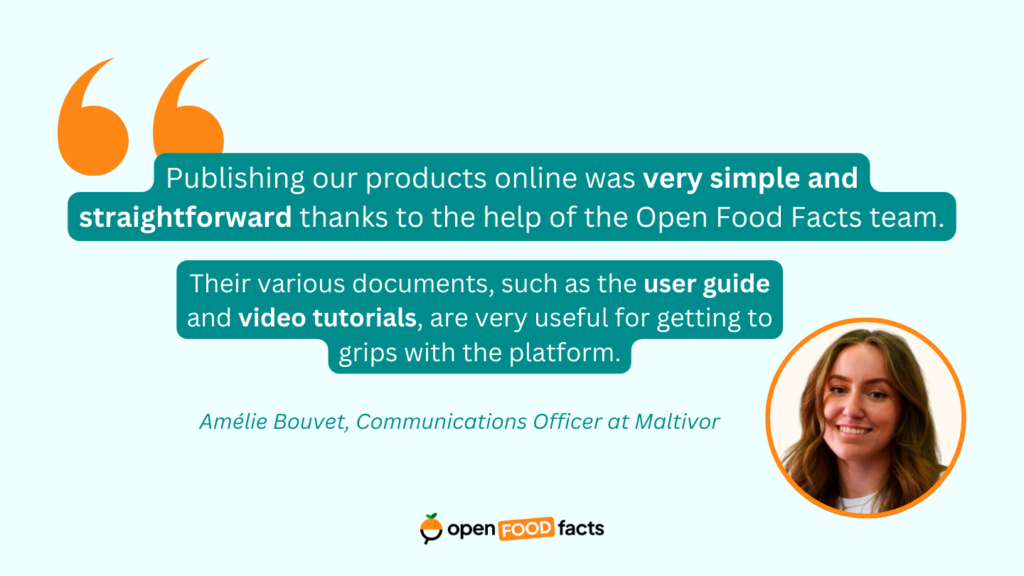
Testimonial from an anti-waste manufacturer: when transparency benefits everyone!
At Open Food Facts, we work with all kinds of audiences: consumers, researchers, mobile applications but also food manufacturers.
We developed the Pro platform 3 years ago to empower food manufacturers in updating their food data, and to offer them free tools for analysing their product portfolio, and in particular to enable them to identify areas for improvement in the Nutri-Scores of their products.
Today, we’re taking you behind the scenes of our chat with Amélie Bouvet from Maltivor, who agreed to share her experience on Open Food Facts as a committed manufacturer!
Happy reading and a big thank you to Amélie for her testimonial! 🙂
To begin with, tell us a little about you and your products.
“Maltivor is helping to build a resilient agri-food sector by producing nutritious, low-impact and tasty ingredients. We are committed to preserving agricultural resources by recycling cereals from local breweries: brewers’ grains.
These cereals, rich in fibre, protein and flavour, are transformed into ingredients with many qualities at our production site. In particular, brewers’ grains are recycled into three types of grain flour: blond, amber and brown. They have three different flavour profiles and can be used in all kinds of applications.
These ingredients are designed for industrialists and craftsmen in the food industry who want to enrich their products with proteins, fibres, minerals, enhance certain flavours or reduce their environmental impact”.
How did you hear about Open Food Facts? 🍊
“We got to know Open Food Facts via various mobile applications that use the open database, such as Foodvisor, Scan Up, MyLabel and even Yuka, which used Open Food Facts to launch itself!”
What motivated you to share your data on Open Food Facts?
“Maltivor has decided to share its data on Open Food Facts in order to be transparent with the people who consume our products. In fact, transparency is a core value for us, so it’s quite obvious for us to share this kind of information with the public. This helps to provide consumers with a better level of information.
Transparency is an important value, because it allows us to build solid and lasting relationships with our partners and customers, all in total authenticity.”
How did you get to grips with the Pro platform? 💻

👉 The famous user guide and video tutorials
How do you use the Nutri-Score and Eco-Score scores? 🚥
“Our draff flours are all Nutri-Score A because they are rich in fibre and protein, so our products are not directly impacted by the new Nutri-Score formula. However, this does give us an argument for our professional customers, so that they can improve their ratings thanks to our ingredients. Thanks to the 40% fibre and 20% protein content of DDGS flour, it can have a positive impact on the nutritional rating of finished products.
We do not display the Nutri-Score directly on our products, as we are targeting a professional clientele made up of industrialists and craftsmen in the food industry. Consumers will have to refer to the Nutri-Score on our customers’ finished products to find out more about them.
We don’t directly display an environmental score on our products either, but this is an argument for our professional customers who are concerned about the impact of their products.
Since the essence of Maltivor is to add value to the co-products of the brewing sector, we demonstrate our commitment to the environment on a daily basis. We’re going one step further by eco-designing the production of our ingredients, creating a tangible and quantifiable positive impact via the Life Cycle Assessment we’re currently developing in-house. For example, Maltivor dried grain flour has a lower environmental impact than other flours.
Its impact on biodiversity and health is reduced, as it uses no additional water or farmland, and no fertilisers or chemicals. It also emits fewer greenhouse gas emissions than other flours, which improves the environmental labelling of finished products.”
And finally, would you share with us a nice recipe using malt draff flour? 🥧
“Draff flour can be used in all kinds of recipes: bakery, biscuit, patisserie and cookery, whether savoury or sweet! One of our star recipes are these cookies.

Ingredients:
- 70g blond, amber or brown draff flour (blond for a cereal flavour, amber for a caramelised taste or brown for roasted and cocoa notes)
- 155g white flour
- 100g butter
- 80g brown sugar
- 80g white sugar
- 1 egg
- ½ sachet baking powder
- 1 pinch of salt
- 100g chocolate in small pieces
- A few drops of vanilla extract
Preparation:
- Soften the butter.
- Preheat the oven to 180°C.
- Mix the butter, sugars and salt until fluffy.
- Add the whole egg and vanilla extract.
- Mix the flour and baking powder and add to the butter/sugar/egg mixture.
- Add the chocolate.
- Form the dough into balls and flatten slightly.
- Bake for 12 minutes at 180°C.
You can find our recipes on our website!
Did you enjoy this article? Find other content on our blog, or follow us on social networks (LinkedIn, Instagram).
✍️ Are you a manufacturer too? Would you like to share your experience with our community? Write to us at producers@openfoodfacts.org to arrange an exchange.
🤝You’re not on the professional platform yet? Create a pro account in 2 minutes or book a videoconference in just a few clicks to find out more about the process.

